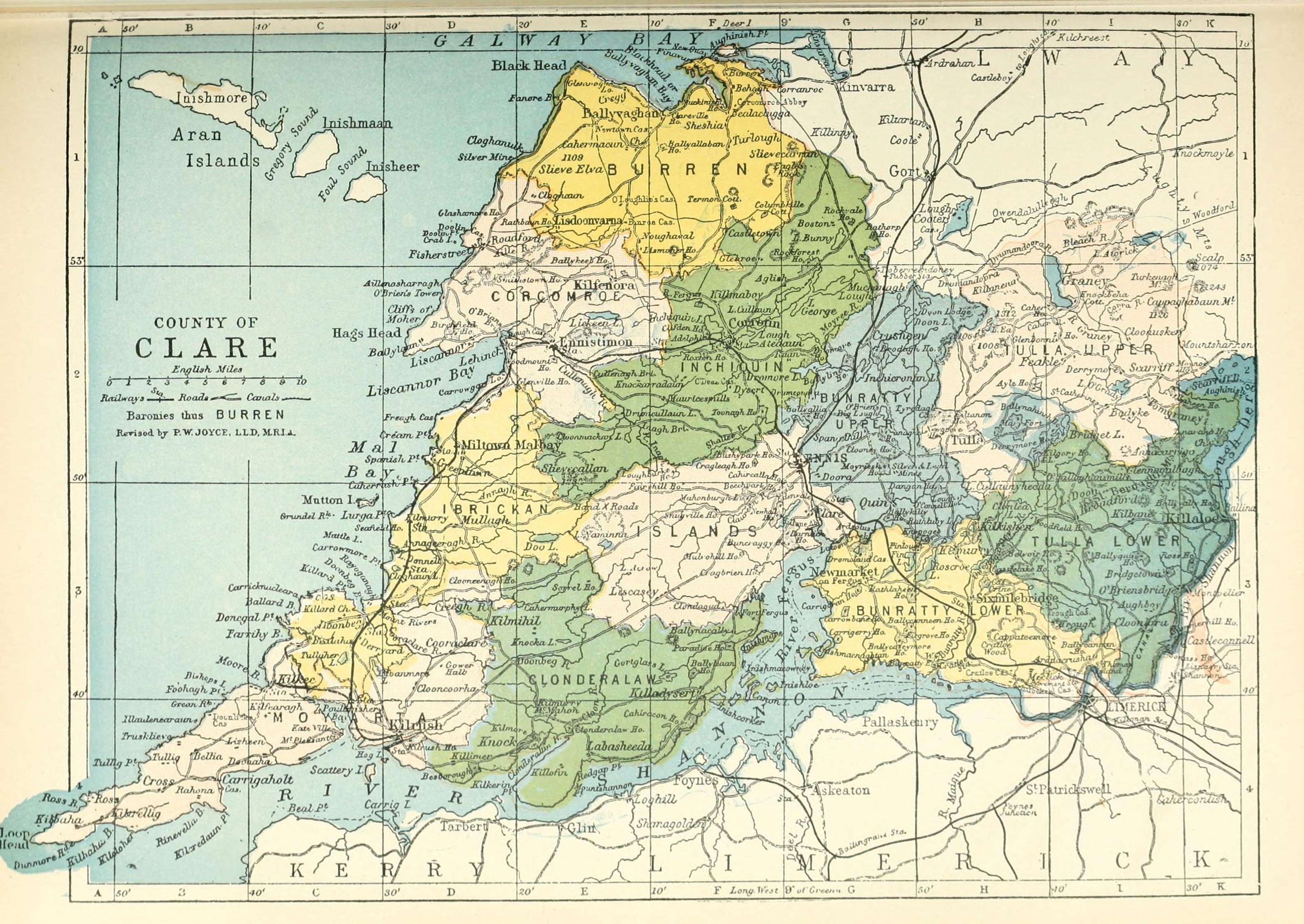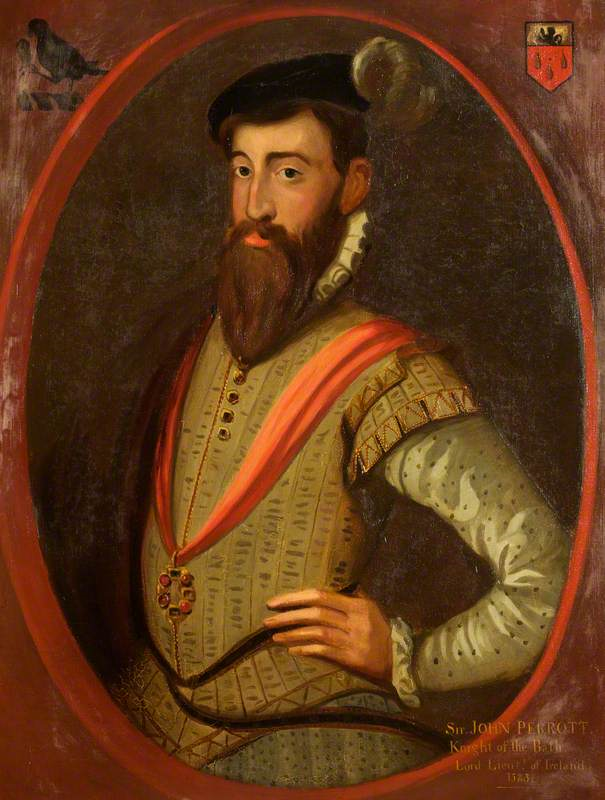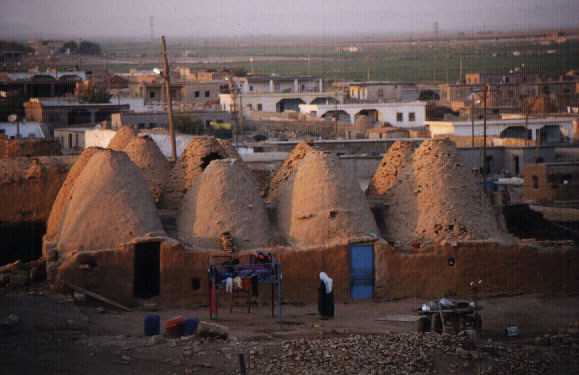|
Cashlaungar
Cashlaungar (), also ''Cashlaungarr'', ''Cashlaun Gar'' or ''Cashlán Gar'', is a stone ringfort (cashel) and National Monument (Ireland), National Monument located in The Burren, a region in County Clare, Republic of Ireland, Ireland. Location Cashlaungar is located in the centre of The Burren, 2.7 km (1.8 miles) south of Carran, overlooking the Kilnaboy–Carran road to the west. It lies at an elevation of . It is located in the townland of Tullycommon, parish of Kilnaboy, not far from the larger ringfort Cahercommaun and Tullycommon Wedge Tomb. History The townland of Tullycommon is probably the ''Tuluauch-comyn'' held by (King Torlough) O'Brien in 1298 as given in the Pipe rolls. Through it in 1317 the army of Diarmait O'Brien reportedly marched on his way to Corcomroe Abbey, "along the fortress-begirt tracks" between Leana and Crughwill. Hugh Roe O'Donnell's troops plundered it in their great raid into Thomond in 1599. Excavation unearthed middens, deer and ox bone ... [...More Info...] [...Related Items...] OR: [Wikipedia] [Google] [Baidu] |
Cashlaungar From The East
Cashlaungar (), also ''Cashlaungarr'', ''Cashlaun Gar'' or ''Cashlán Gar'', is a stone ringfort (cashel) and National Monument located in The Burren, a region in County Clare, Ireland. Location Cashlaungar is located in the centre of The Burren, 2.7 km (1.8 miles) south of Carran, overlooking the Kilnaboy–Carran road to the west. It lies at an elevation of . It is located in the townland of Tullycommon, parish of Kilnaboy, not far from the larger ringfort Cahercommaun and Tullycommon Wedge Tomb. History The townland of Tullycommon is probably the ''Tuluauch-comyn'' held by (King Torlough) O'Brien in 1298 as given in the Pipe rolls. Through it in 1317 the army of Diarmait O'Brien reportedly marched on his way to Corcomroe Abbey, "along the fortress-begirt tracks" between Leana and Crughwill. Hugh Roe O'Donnell's troops plundered it in their great raid into Thomond in 1599. Excavation unearthed middens, deer and ox bones. Description This cashel is a stone fort situ ... [...More Info...] [...Related Items...] OR: [Wikipedia] [Google] [Baidu] |
Kilnaboy
Kilnaboy or Killinaboy () is a village, townland and civil parish in County Clare, Ireland. It is located in the Burren, and as of the 2011 census the area had 347 inhabitants. Civil parish Kilnaboy is a parish in the historic Barony (Ireland), Barony of Inchiquin. Its chief town, Corofin, is located on the southern extremity of the parish. It is mentioned with regard to the Papal taxation of 1302-06. Geography Three kilometres north of Corofin, the village is on the southeastern border of the limestone hills of the Burren and extends both into the lowlands to the south and into the hills to the north. Mullaghmore mountain is close by. There are extensive tracts of bog in the eastern portion of the parish. According to the 1837 survey of Lewis:"The surface is boldly diversified and embellished with the picturesque lakes of Inchiquin and Tadune, the latter of which is but partly in the parish. The lake of Inchiquin is about 2½ miles in circumference, and is situated at the b ... [...More Info...] [...Related Items...] OR: [Wikipedia] [Google] [Baidu] |
Carran
Carran (), also Carron, is a small village in County Clare, Ireland. It is in the Burren region, within a Civil parishes in Ireland, civil parish of the same name. It is notable mainly for being the birthplace of Michael Cusack, the inspirer and co-founder of the Gaelic Athletic Association. At the time of the 2011 Census, Carran had 106 inhabitants. Geography Carran parish is located on the uplands of the Burren and is bounded on the northwest by County Galway and on the south by Kilnaboy. ''Slieve Carran'', one of the highest points in the Burren, lies north of the village. The land is mainly rocky pasture with much limestone. In the past there were copper mines. It is said that Saint Columb founded an abbey at Glanculmkil, later to become the parish church. An 1837 account said this church was in ruins, and there were the remains of two other old churches at Crunane and Glanculmkil. A stone bed is called Saint Columb's bed, and nearby is a spring of fine water. The ... [...More Info...] [...Related Items...] OR: [Wikipedia] [Google] [Baidu] |
Thomas Johnson Westropp
Thomas Johnson Westropp (16 August 18609 April 1922) was an Irish antiquarian, folklorist and archaeologist. Career Westropp was born on 16 August 1860 at Attyflin Park, Patrickswell, County Limerick. His relatives were landowners of English origin and had lived there since the mid 16th century. He displayed an early interest in antiquities, making notes on topography, ancient buildings and folk life whenever his family would make trips into the neighbouring counties. He attended Trinity College Dublin and graduated in 1882 with an MA. A degree in civil engineering followed in 1885, at which time he was apprenticed to Bindon Blood Stoney, who was engaged in a project to widen and dredge the entrance to the Port of Dublin. After he finished his training, Westropp became the assistant Surveying, surveyor for County Meath, but soon abandoned his professional work to pursue his archaeological interests. He spent the remainder of his life researching antiquities along the western ... [...More Info...] [...Related Items...] OR: [Wikipedia] [Google] [Baidu] |
County Clare
County Clare () is a Counties of Ireland, county in the Provinces of Ireland, province of Munster in the Southern Region, Ireland, Southern part of Republic of Ireland, Ireland, bordered on the west by the Atlantic Ocean. Clare County Council is the Local government in the Republic of Ireland, local authority. The county had a population of 127,938 at the 2022 census of Ireland, 2022 census. The county seat and largest settlement is Ennis. Etymology There are two main hypotheses for the origins of the county name "Clare". One is that the name is derived from Thomas de Clare, Lord of Thomond, Thomas de Clare an Anglo-Norman peer and soldier from the de Clare family, who was deeply embroiled in local politics and fighting in the 1270s and 1280 and had had acquired land in Kilkenny and Thomond that included the Castle of Clare. In 1590 County Clare was named after the castle, which is in a strategic location. An alternative hypothesis is that the county name ''Clare'' comes from ... [...More Info...] [...Related Items...] OR: [Wikipedia] [Google] [Baidu] |
Hugh Roe O'Donnell
Hugh Roe O'Donnell II (; 20 October 1572 – 30 August 1602), also known as Red Hugh O'Donnell, was an Irish Chief of the Name, clan chief and senior leader of the Irish confederacy during the Nine Years' War (Ireland), Nine Years' War. He was Lord of Tyrconnell from 1592 until his death in 1602. He was born into the powerful O'Donnell dynasty, O'Donnell clan of Tyrconnell (present-day County Donegal). By the age of fourteen, he was recognised as his clan's Tanistry, tanist and engaged to the daughter of the prominent Hugh O'Neill, Earl of Tyrone, Earl of Tyrone. The Dublin Castle administration, English-led Irish government feared that an alliance between Tyrone and the O'Donnell clan would threaten the Crown's control over Ulster, so in 1587 Lord Deputy of Ireland, Lord Deputy John Perrot arranged Hugh Roe's kidnapping. The government subsequently backed regime change in Tyrconnell. After four years' imprisonment in Dublin Castle, Hugh Roe escaped circa January 1592 with the ... [...More Info...] [...Related Items...] OR: [Wikipedia] [Google] [Baidu] |
Archaeological Sites In County Clare
Archaeology or archeology is the study of human activity through the recovery and analysis of material culture. The archaeological record consists of artifacts, architecture, biofacts or ecofacts, sites, and cultural landscapes. Archaeology can be considered both a social science and a branch of the humanities. It is usually considered an independent academic discipline, but may also be classified as part of anthropology (in North America – the four-field approach), history or geography. The discipline involves surveying, excavation, and eventually analysis of data collected, to learn more about the past. In broad scope, archaeology relies on cross-disciplinary research. Archaeologists study human prehistory and history, from the development of the first stone tools at Lomekwi in East Africa 3.3 million years ago up until recent decades. Archaeology is distinct from palaeontology, which is the study of fossil remains. Archaeology is particularly important for learni ... [...More Info...] [...Related Items...] OR: [Wikipedia] [Google] [Baidu] |
National Monuments In County Clare
National may refer to: Common uses * Nation or country ** Nationality – a ''national'' is a person who is subject to a nation, regardless of whether the person has full rights as a citizen Places in the United States * National, Maryland, census-designated place * National, Nevada, ghost town * National, Utah, ghost town * National, West Virginia, unincorporated community Commerce * National (brand), a brand name of electronic goods from Panasonic * National Benzole (or simply known as National), former petrol station chain in the UK, merged with BP * National Book Store, a bookstore and office supplies chain in the Philippines * National Car Rental, an American rental car company * National Energy Systems, a former name of Eco Marine Power * National Entertainment Commission, a former name of the Media Rating Council * National Motor Vehicle Company, Indianapolis, Indiana, USA 1900–1924 * National Radio Company, Malden, Massachusetts, USA 1914–1991 * National Supermarket ... [...More Info...] [...Related Items...] OR: [Wikipedia] [Google] [Baidu] |
Beehive House
A beehive house is a building made from a circle of stones topped with a domed roof. The name comes from the similarity in shape to a straw beehive. Occurrences The ancient Bantu used this type of house, which was made with mud, poles, and cow dung. Early European settlers in the Karoo region of South Africa built similar structures known as corbelled houses. These white-washed structures are described as coursed rubble on a circular plan, with each successive course smaller and slightly corbelled over the course below so that a conical shape is achieved as each course is completed. Beehive houses are some of the oldest known structures in Ireland and Scotland, dating from as far back as around 2000 BC. Bee houses have also been built in the Italian peninsula, with some still being built as late as the 19th century in Apulia (south-eastern Italy). In Southern Italy, these houses are called '' trulli'' while its prehistoric Sardinian versions were referred to as ''nuraghi''. ... [...More Info...] [...Related Items...] OR: [Wikipedia] [Google] [Baidu] |
Gatehouse
A gatehouse is a type of fortified gateway, an entry control point building, enclosing or accompanying a gateway for a town, religious house, castle, manor house, or other fortification building of importance. Gatehouses are typically the most heavily armed section of a fortification, to compensate for being structurally the weakest and the most probable attack point by an enemy. There are numerous surviving examples in France, Austria, Germany, England and Japan. History Gatehouses made their first appearance in the early antiquity when it became necessary to protect the main entrance to a castle or town. Famous early examples of such gates are those such as the Ishtar Gate in Babylon. Over time, they evolved into very complicated structures with many lines of defence. The Romans began building fortified walls and structures throughout Europe such as the Aurelian Walls of Rome with gates such as Porta San Paolo and Porta Nigra from the ancient defenses of Trier in Germany. Str ... [...More Info...] [...Related Items...] OR: [Wikipedia] [Google] [Baidu] |
Deer
A deer (: deer) or true deer is a hoofed ruminant ungulate of the family Cervidae (informally the deer family). Cervidae is divided into subfamilies Cervinae (which includes, among others, muntjac, elk (wapiti), red deer, and fallow deer) and Capreolinae (which includes, among others reindeer (caribou), white-tailed deer, roe deer, and moose). Male deer of almost all species (except the water deer), as well as female reindeer, grow and shed new antlers each year. These antlers are bony extensions of the skull and are often used for combat between males. The musk deer ( Moschidae) of Asia and chevrotains ( Tragulidae) of tropical African and Asian forests are separate families that are also in the ruminant clade Ruminantia; they are not especially closely related to Cervidae. Deer appear in art from Paleolithic cave paintings onwards, and they have played a role in mythology, religion, and literature throughout history, as well as in heraldry, such as red deer that app ... [...More Info...] [...Related Items...] OR: [Wikipedia] [Google] [Baidu] |









